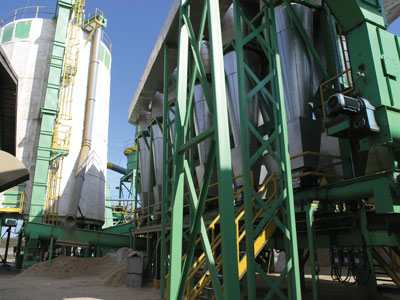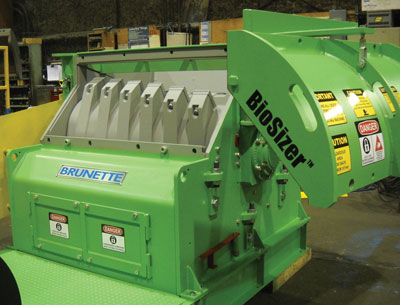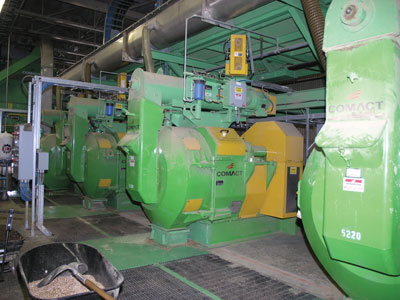
Facing the Future
December 2, 2011
By
Scott Jamieson
Trebio’s management team and much of its start-up staff can trace their roots to Quebec’s sawmilling sector.
Trebio’s management team and much of its start-up staff can trace their roots to Quebec’s sawmilling sector. The plant itself is housed in what’s left of an old pulp and paper operation on the Quebec-Ontario border. The CN Rail line that will move its bulk pellets to market was originally built to move forest products, not as an energy pipeline to the United States or Europe.
 |
|
| The single-pass rotary dryer and cyclones were supplied by bulk drying pioneer Thompson Dehydrating Co. In the background: A reversing screw at the dry bin infeed allows problematic material to be dumped to the ground out of harm’s way.
|
Yet move energy it will, as the company’s flagship pellet mill started bagging whitewood pellets in June, and was ramping up production when Canadian Biomass was on site in late September.
Trebio ( www.trebio.ca) is a new player in the bioenergy market, and as CEO and shareholder Louis Campeau explains it, came about in part by chance. Campeau has a long history in Canada’s sawmilling sector, having worked for Davidson Industries in the region for much of his career. The company was a major player in the white pine market, with mills in Canada, the United States, and Brazil. Tembec bought it in the early ’90s, but its Canadian mills have been shuttered for years now. A few years ago, while looking for his next adventure, Campeau had a visitor from the U.K.
“Peter Bonsall came to Canada looking for wood pellets. He stayed at my place for the weekend. I didn’t know anything about pellets, but we got to talking, and by the end of the weekend I said, ‘I can do that; I can get the fibre, let’s do this.’”
Fibre first
From that initial idea, the pair moved into action. The first step was to secure fibre for a greenfield pellet operation. By that time, Quebec’s traditional forest industry was under considerable stress, and close to 50% of the sector’s lumber production and a good part of its pulp and paper sector were shuttered. They secured a CAAF (Quebec annual allowable cut) of 169,000 m3 and started building relationships with area contractors and sawmills to ensure they would have easy access to the 260,000 m3 they would need to reach full capacity.
 |
|
| The Brunette BioSizer provides a lot of flexibility up front, handling bark for the KMW energy system but pinch-hitting to create raw material for production as required. |
“Fibre is not an issue for us here,” Campeau says. “We will be able to get the fibre we need, at the price we need, for the foreseeable future.”
With fibre in hand, the next step was to find a suitable partner who knew about making and selling pellets. “We were not comfortable launching something on this scale with our initial knowledge base,” says Campeau. “We met the players at GF Energy from the Netherlands, who are intimately involved in the bioenergy sector, we went on a few dates, liked what we saw, and eventually got married,” he concludes with a smile.
Out of this, Trebio evolved into a joint ownership model between GF Energy and four partners on the management team: Bonsall in the U.K., Campeau, operations manager Yann Sellin, and Marcel Belair. They also arranged some external financing, including some government support, as well as private finance.
“That took some time,” Campeau recalls of the $20-million investment. “For the banks, we were still forestry, not energy, and they were not keen to make forestry loans at the time. But we found a bank, got the finances in order, and got started.”
First of its kind
The mill itself is a turnkey project from longtime sawmill machinery supplier Comact. The company has built over 100 turnkey sawmills around the world, and was no stranger to the Trebio management team. Thanks in part to some introductions from Yann Sellin, Comact had also started representing the French pellet machinery supplier Promill in North America, and now had the gear and knowledge base to extend that turnkey experience into the pellet sector.
 |
|
| Pelletizing is via five Promill pellet mills supplied by Comact. The mills are designed for fast maintenance access and to avoid lubricant contamination of the final product.
|
Trebio is both Comact’s first turnkey pellet mill, and the first Promill installation in Canada, but the managers were comfortable with the choice.
“We had a solid knowledge of Comact from the sawmill side,” explains Sellin, who was intimately involved with the plant design from Day 1. “At the same time, I knew Promill well from touring around pellet mills in France and talking to the owners and managers there about the equipment. This was not a big leap for us.”
While Sellin, Comact, and Promill were hammering out the design, Trebio was finalizing the plant location. They settled on an old pulp and paper mill site most recently owned by Smurfit Stone in Portage du Fort, Quebec. Just over the Ottawa River in Quebec, the site is serviced by a direct CN Rail link that can take product out to the St. Lawrence via the port of Trois Rivières.
It is also perched on the only bridge across the river between Ottawa and Pembroke, allowing sawmillers in the Ottawa Valley easy access to a largely untapped fibre supply. Finally, with the addition of infrastructure like power and water, and a few usable buildings, everything was in place to begin.
Construction on the mill started in September 2010, with commissioning starting in June 2011, basically on time and on budget.
Flexible infeed
While it started up using over 90% sawmill residuals, the mill is designed to handle a mix of roundwood and chips/sawdust. The final fibre mix will likely be 60% roundwood and 40% sawmill residuals. The mill has hired a local contractor to run a mobile horizontal grinder in the mill yard to convert roundwood to usable fibre, a process that was set to start in late September.
Depending on quality, fibre can either go to a Schutte-Buffalo wet hammermill, or a Brunette BioSizer. The latter was added to handle the mill’s bark intake for the energy system, but was also chosen to give the mill some flexibility, as Sellin explains.
“It’s mostly for bark, but Comact set it up so that it can be fed from both sides, and used with smaller screens to pre-grind the chips to bypass the green hammermill if need be, or to deal with fibre quality issues. It gives us a lot of flexibility to keep the plant running no matter what.”
After the BioSizer or green hammermill, fibre is sent to the single-pass rotary dryer. Bulk material drying pioneer Thompson Dehydrating Company out of Kansas supplied it, along with the cyclones. Process heat is supplied by a 16 MW system from KMW out of London, Ontario, who was on site during our visit, ramping both the energy system and dryer up to full production capacity.
From here fibre goes to a dry storage bin, which at six to eight hours is the plant’s only significant surge capacity, as Sellin explains.
“After the dry hammermill, it is way too dangerous to build in any surge capacity in my opinion. We looked at it, and I had to battle that one out with a few people who wanted additional surge there, but I didn’t feel comfortable at all with the explosion risk.”
In fact, Sellin adds that safety was an overriding design principle all the way through the process. He had seen far too many dangerous situations in his travels, and was not willing to accept that same hazardous working environment at Trebio.
The company approached its insurance partners, Lumbermen’s Underwriting Alliance, and asked them what they would want to see in an ideal pellet mill. The insurers handle the majority of the pellet sector, and so had a good idea of what they wanted.
“They basically came up with a wish list for the ideal plant as far as fire and explosion safety goes, and that’s what we did,” Campeau says. “Now it’s their model for other plants.”
The plant is protected at all risk areas from the output of the dryer to the end of the process by a Flamex MiniMax spark detection and suppression system, but that is just a start, Sellin notes.
“The process and all the presses are controlled by PLCs, so we can proactively manage for changing conditions. There are temperature probes in the mills alerting us to any risks. And we’ve added safety measures that also allow us to maintain production at higher levels, safely.”
One such touch is a reversing screw at the infeed to the dry bin. Not only does this allow operators to dump out material to the ground below whenever there is possible danger, but it also means they can easily get rid of wet material before it contaminates the dry bin or disturbs downstream production.
“I’m very happy to have done that. Otherwise you end up with a nightmare in the dry bin or in your pellet mills. I’m sure we’ve increased production by 25% just because we handle issues out here.”
Trebio has also avoided some explosive situations by keeping much of the dry material handling process outside. The entire process, from fibre intake through drying, the dry bin, and even the Schutte-Buffalo dry hammermill, takes place in Mother Nature’s playground. Only at the infeed to the pellet mills does the process move into a confined space, a compromise Sellin is very comfortable with.
“There may be some challenges in winter, although we don’t get the heavy snow here they do in other regions. In any event, we’re making something very explosive here – it’s a fuel. We kept that in mind every time we had to balance our decision making.”
Another long-term supplier to the forest products sector, Rodrigue Metal (RodAir), supplied the dust control and pneumatic handling systems.
Moving inside
Pelletizing occurs in five Promill pellet mills, all painted and branded Comact. Pellets are transferred to a Promill cooling station designed to minimize the creation of fines, and then to an interior storage area, where they are held for 24 hours prior to bagging.
“When I was touring France and Estonia, I heard the same story every time – if you’re going right from production to bags, there is always a little bit of moisture that will play havoc down the road. So we made the decision to store product in the warehouse for 24 hours to allow it to cool down correctly and remove all the potential moisture in the product before it is sealed in bags for our clients.”
The mill can bag 100% of its product in smaller consumer bags or larger one-ton bulk bags, allowing for market flexibility. The automated bagging line is from Quebec supplier Premier Tech.
Depending on how much domestic bagging is required, total plant staff will settle somewhere between 35 to 50 people. According to Sellin, staffing up with the right people was not an issue.
“There were many people from our sawmilling days that were keen to come back and work with us. It’s a new process, and they’re all excited to come here and make it work. That makes my job a lot easier,” he adds as he wanders back in to continue the challenging work of ramping up a new pellet mill.
Overall, Sellin is pleased with the plant design and layout. “We haven’t seen any major design issues that need to be addressed. It’s more about fine-tuning the processes to reach the plant’s potential.”
Print this page